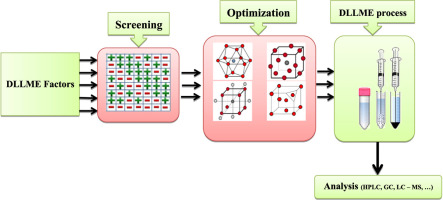Talanta ( IF 6.1 ) Pub Date : 2018-08-06 , DOI: 10.1016/j.talanta.2018.08.002 Leila Mousavi , Zahra Tamiji , Mohammad Reza Khoshayand

|
Nowadays, the trend to simplify and miniaturize sample preparation methods has resulted in the development of effective and low-cost microextraction techniques that utilize a very small volume of the extracting phase. Among them, the liquid–liquid microextraction (LLME) method is a simple and effective sample pre-treatment technique applicable to numerous analytical methods. A related miniaturized and environmentally friendly extraction technique, dispersive liquid–liquid microextraction (DLLME), has been developed within the last decade and shows a very high enrichment factor and very low solvent consumption compared to other liquid- or even solid-phase extraction methods. The inclusion of several effective parameters in DLLME and its variants has increased the need for optimization to obtain the best possible extraction results. In fact, experimental design and optimization of performance conditions are the most important applications of chemometrics in analytical chemistry. Thus, design of experiments (DoE) helps us to determine the best model of the relationship between variables, as well as the optimal experimental conditions. Here, a comprehensive review of recent advancements in the use of DoE methodologies including full factorial, fractional factorial, Plackett–Burman, orthogonal array, central composite, Box–Behnken, Doehlert, and D-optimal designs to optimize DLLME applications is provided. In addition, the preponderance and drawbacks of each optimal method are discussed. The overall purpose of this review is to present a general overview of the different DoEs that are currently used to optimize DLLME for various matrices and analytes.
中文翻译:

分散液-液微萃取方法实验设计的应用和机遇–综述
如今,简化和小型化样品制备方法的趋势导致了开发有效且低成本的微萃取技术,该技术利用了非常少量的萃取相。其中,液-液微萃取(LLME)方法是一种简单有效的样品预处理技术,适用于多种分析方法。在过去的十年中,已开发出一种相关的小型化,环境友好型萃取技术,即分散液-液微萃取(DLLME),与其他液相或什至固相萃取方法相比,它显示出很高的富集系数和极低的溶剂消耗。在DLLME及其变体中包含几个有效参数,增加了对进行优化以获得最佳可能提取结果的需求。实际上,实验设计和性能条件的优化是化学计量学在分析化学中最重要的应用。因此,实验设计(DoE)帮助我们确定变量之间关系的最佳模型以及最佳实验条件。在这里,提供了对使用DoE方法的最新进展的全面回顾,包括完整阶乘,分数阶乘,Plackett-Burman,正交数组,中心复合,Box-Behnken,Doehlert和D最优设计以优化DLLME应用。此外,还讨论了每种最佳方法的优势和劣势。这篇综述的总体目的是介绍当前用于优化各种基质和分析物的DLLME的不同DoE的概述。



























 京公网安备 11010802027423号
京公网安备 11010802027423号